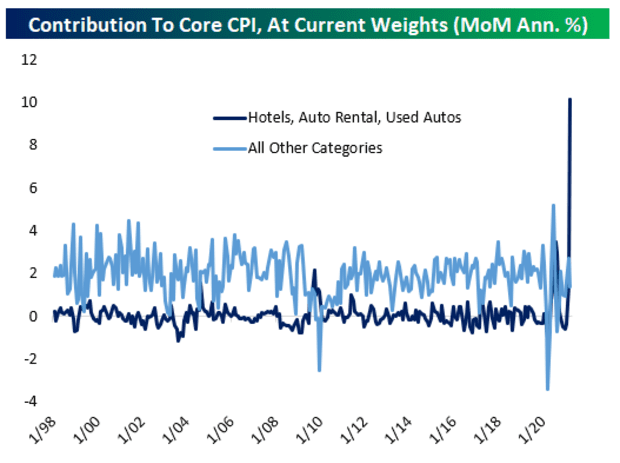This post was originally published on this site
It has been a bad week for stocks, and it doesn’t look like a turnaround is coming on Thursday. The S&P 500 has tumbled near 4% since the beginning of the week as investors panic about inflation, with stock market futures pointing to more declines in the day ahead.
Is it possible for investors to stay bullish? Our call of the day, from strategists Nicholas Colas and Jessica Rabe of DataTrek Research, describes the historical precedent and two beliefs investors must hold to remain long on U.S. stocks.
The S&P 500
SPX,
only rarely sees a period of three years in a row with 10%-plus total annual returns, Colas and Rabe said. It has happened five times: amid World War II; around the Korean War; in the early-mid 1960s; during the 1995 to 1999 bull market; and once this millennium, from 2012 to 2014.
“This matters — a lot — just now because the S&P 500 is up 10.5% year-to-date and we’ve just had two back-to-back 10%-plus years,” the strategists said. “To buy or hold the S&P 500 right here you need to believe other investors believe there’s another 10% coming in the next 12-18 months.”
On the one hand, there is an easy macro story about how fiscal policy is beating back an existential threat — COVID-19 — similar to World War II, they said. On the other, it is a tough sell to believe markets will materially misprice corporate earnings power three years in a row, which happens so rarely.
“If you are tempted to reduce U.S. equity exposure right here, right now, history is certainly on your side,” the strategists said.
However, Colas and Rabe are still of the mind-set that earnings expectations will keep climbing, and companies will be able to beat elevated expectations.
There are two pillars that this conviction lies on. One, that U.S. consumers’ ability and desire to spend is extremely high. And two, that companies have underappreciated earnings leverage. If both are true, Colas and Rabe said, investors will believe in a 10%-plus year in 2022, and the bull market will keep charging in 2021.
“That’s what you have to believe to stay long the S&P 500 here; no other explanation really works,” the strategists said.
The chart

Chart from Bespoke Investment Group via Irrelevant Investor blog
Wednesday’s inflation reading was a showstopper. The Core Consumer Price Index, which strips out the volatile influence of food and energy prices, rose 3% year-over-year in April and 0.9% from March — the biggest one-month jump since 1982.
Our chart of the day comes courtesy of Michael Batnick at the Irrelevant Investor financial blog, and it shows how certain areas of the economy are driving inflation more than others.
“The apparent surge in inflation in April is mostly a reflection of the economy’s reopening and the idiosyncrasies of the used-vehicle market,” explains Matthew C. Klein, the economics commentator at Barron’s. “Investors should discount inflation headlines and focus on what’s going on under the hood by examining the specific categories driving the changes in the price level.”
The buzz
Shares in Alphawave crashed as much as 20% after it floated in London to raise $1.2 billion. The chip developer’s initial public offering — a rare move to go public on the other side of the Atlantic — comes amid a push from the U.K. government to make London a tech listing hot spot to rival the likes of New York.
On the economic front, investors can expect initial jobless claims for last week at 8:30 a.m. Eastern, along with continuing jobless claims and the producer-price index. It is expected that around 500,000 Americans filed for unemployment last week.
The Colonial Pipeline has restarted operations, but it will take several days to return to normal. The largest fuel pipeline in the U.S. was shut down last Friday in a cyberattack.
Tesla
TSLA,
Chief Executive Elon Musk said the electric-car maker would stop accepting bitcoin as payment for cars due to the environmental damage from the use of fossil fuels for bitcoin mining. The price of bitcoin
BTCUSD,
tumbled as much as 14% before settling 9% lower, below $50,000.
Ohio will give away $1 million prizes and college scholarships as incentives for people to get vaccinated against COVID-19.
The co-creator of the cryptocurrency network ethereum
ETHUSD,
Vitalik Buterin, donated more than $1 billion to a relief fund to combat the COVID-19 outbreak in India.
The successor to “Bond King” Bill Gross at Janus Henderson is stepping down. Nick Maroutsos, the head of global bonds at the asset manager, will leave in October 2021 to take a career break.
The markets
U.S. stock market futures
ES00,
NQ00,
are pointing to another day of declines ahead amid inflation fears. Dow industrials futures
YM00,
were indicating an open 140 points lower, after closing 681 points below on Wednesday to mark the worst three-day stretch since October 2020.
Equities tumbled in Europe
SXXP,
DAX,
playing catch-up with the Wall Street selloff, while stocks across Asia fell
NIK,
Random reads
Bucktooth bandits battle lumber prices in Canadian heist: Mounties traced a pile of stolen Saskatchewan lumber to…a beaver dam.
A flammable foible: “Do not fill plastic bags with gasoline,” U.S. officials warn the public, as fuel shortages bite.
Need to Know starts early and is updated until the opening bell, but sign up here to get it delivered once to your email box. The emailed version will be sent out at about 7:30 a.m. Eastern.
Want more for the day ahead? Sign up for The Barron’s Daily, a morning briefing for investors, including exclusive commentary from Barron’s and MarketWatch writers.

